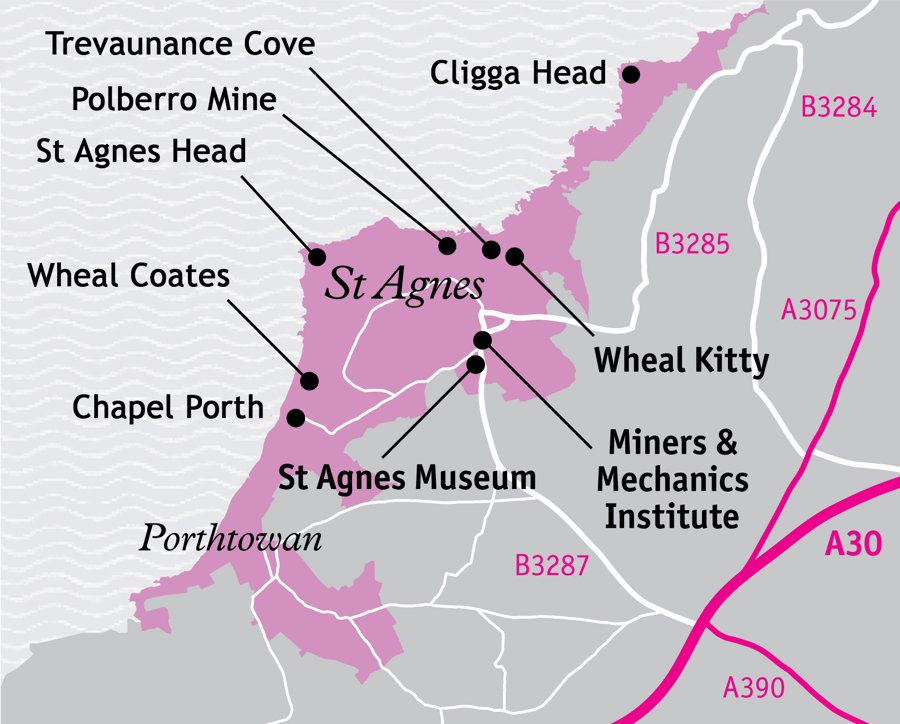Visit - A7 St Agnes Mining District
A7 St Agnes Mining District - Ranndir Balweyth Breanek
Iconic clifftop engine houses and much more
Famous for its spectacular coastline and well-preserved Cornish engine houses perched on rugged cliffs, such as the iconic Wheal Coates; one of the most photographed and well-known Cornish Engine Houses. This Area also has a rich heritage to explore inland, from the tin treatment works in narrow stream valleys to the pretty village with its granite mineworkers’ cottages, fine public buildings and luscious gardens.
‘If you’re lucky you might catch a glimpse of the dolphins that play off the coast in the summer’.
Places to visit
Wheal Coates qualifies as a Cornish icon with some of the most photographed mine buildings in the UK.
Clinging to the cliff edge along from St Agnes Head and just up from Chapel Porth beach, the historic remains of the Towanroath pumping engine house, stamps and winding engine houses are both dramatic and impressive.
St Agnes Museum is full of fascinating artefacts and information about the Parish of St Agnes. There’s lots about our rich mining and maritime history with a detailed model of the former harbour and our fabulous Lady Agnes figurehead.
There are many interesting items in our collection relating to farming, folklore, religion, archaeology, domestic bygones, life in the Victorian era, and much more. Our Museum is a real ‘cabinet of curiosities’!
Located within the Cornwall National Landscape and World Heritage Site, Trevaunance Cove has the remains of the historic mineral harbour, which can be explored on the western side of the beach at low tide. Historically, St Agnes' has been especially rich in tin and evidence of mine workings in the form of small openings can be seen dotted throughout the cliffs here
The St Agnes Mining District is Area A7 of the World Heritage Site and there is a wealth of mining heritage to discover in an outstandingly beautiful part of the Cornwall National Landscape. Hop on the U1A outside Truro railway station and the bus will take you to the heart of St Agnes. It’s just a case of deciding where you go when you get there.
Here are some ideas:
Explore St Agnes and look out for the signs of mining heritage in the heart of the village. Don’t miss St Agnes Museum – a great place to discover more about the history of this fascinating village and the industries that shaped the local landscape - https://stagnesmuseum.org.uk/. For more ideas check out our audio trail around the St Agnes at https://www.cornishmining.org.uk/areas/st-agnes-mining-district
The stretch of the South West Coast Path passing through Area A7 is one of the most spectacular places to explore mining heritage with its iconic engine houses perched on dramatic cliff tops set amongst fabulous coastal heaths. Head west on the coast path from St Agnes village towards Chapel Porth where you can pick up the National Trust’s Wheal Coates tin mining walk - https://www.nationaltrust.org.uk/visit/cornwall/wheal-coates/wheal-coates-tin-mining-walk
A less well known stretch of the coast path is from St Agnes (Trevaunance Cove) to Cligga Head passing through the hidden mining landscape of Trevellas Coombe. From Cligga Head, there is the option to continue onto Perranporth where you can pick up the U1A bus back to St Agnes and/or Truro.
Scale the heights of St Agnes Beacon and enjoy a bird’s eye view of the surrounding landscape. There are lots of signs of mining heritage from engine houses and chimneys to the patchwork of small fields, once former mineworkers’ smallholdings often reclaimed from areas of mine waste as part of the subsistence lifestyle of local miners. Check out the South West Coast Path’s 6.3 mile circular walk from St Agnes that takes in the Beacon and the dramatic coast around Chapel Porth - https://www.southwestcoastpath.org.uk/walksdb/201/
